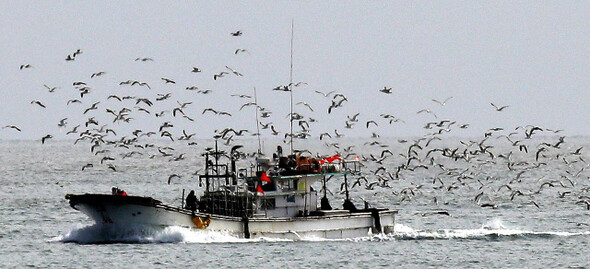hankyoreh
Links to other country sites 다른 나라 사이트 링크
Hope that Kerry and China can bring N. Korea into dialogue

By Park Byong-su, staff reporter
Last weekend, tensions on the Korean Peninsula seemed to begin calming. The combination of President Park Geun-hye’s offer of inter-Korean dialogue and US Secretary of State John Kerry’s message that he was willing to sit down with the leaders in Pyongyang has had an alleviating effect on the situation.
But the situation remains fluid. A South Korean government official said, “North Korean people are obviously concerned about how North Korea is going to take Mr. Kerry’s message.”
“The dust is going to have to settle a bit before we know exactly what happened and what to do next,” the official added, suggesting tensions might boil over again depending on how North Korea responds.
Indeed, it is still unclear just what path Pyongyang will take. If it renews its barrage of heavy provocations with missile launches and so on, the crisis could very well deteriorate beyond repair. The result may be a repeat of the traditional cycle of provocations met with United Nations Security Council sanctions, which are in turn met by more provocations.
“The situation cooled down a bit with the dialogue offers from Seoul and Washington,” said Ewha Womans University professor Cho Dong-ho. “Now the real questions start.”
Cho said the biggest question of all would be how Pyongyang responds over the next few days.
The first reaction from Pyongyang was not promising. On Apr. 14, Pyongyang blasted Park’s dialogue offer as a “cunning ploy,” prompting Seoul to respond with “dismay” at what it saw as a rejection.
Even the dialogue back-and-forth over the shutdown of the Kaesong Industrial Complex couldn’t get the ball rolling again with talks. Each side merely denounced the other and expressed dismay, killing any momentum there might have been.
Still, the possibility of dialogue remains alive. According to Inje University professor Kim Yeon-chul, the emphasis in the message from Pyongyang was on Park’s offer being an “empty shell.”
“It looks like the South Korean government needs to offer something more substantive,” Prof. Kim said.
In the broader scheme of things, the more important variable will be Pyongyang’s response to Kerry’s message. Kerry repeatedly stressed Washington’s readiness to enter dialogue if North Korea denuclearizes during his three-day tour of Northeast Asia, which began on Apr. 12. He also suggested a willingness to hold direct talks between Washington and Pyongyang, which the US has steered clear of since an agreement reached on Feb. 29 of last year broke down.
Perhaps in consideration of this, North Korea eschewed any denunciations of the US - or any references to it at all - in an Apr. 14 statement from a Committee for the Peaceful Reunification of the Fatherland spokesperson, which blasted the South Korean government.
On Apr. 13, Kerry said Washington and China had agreed that the nuclear issue “should be handled and resolved peacefully through dialogue and consultation”. There remarks are calling attention to China’s role in the days ahead.
Beijing appears very likely to try to win Pyongyang over following Kerry’s message of dialogue. It has frequently played a major role in dialogue on the peninsula, as with the Feb. 29 agreement between the US and North Korea last year. After a January 2011 summit meeting between Obama and then-Chinese President Hu Jintao resulted in an agreement to pursue the peace, stability, and denuclearization of the Korean Peninsula, China took on a proactive role, mediating behind the scenes for talks between Pyongyang and Washington, resulting in the Feb. 29 agreement.
North Korea appears to be holding off from any additional provocations, including missile launches, as it watches the situation closely. No activity with transporter erector launchers (TELS) was detected in Wonsan and South Hamgyong provinces after Apr. 11, the day of Park’s proposal for inter-Korean dialogue.
Please direct questions or comments to [english@hani.co.kr]

Editorial・opinion
![[Column] Season 2 of special prosecutor probe may be coming to Korea soon [Column] Season 2 of special prosecutor probe may be coming to Korea soon](https://flexible.img.hani.co.kr/flexible/normal/500/300/imgdb/original/2024/0426/3317141030699447.jpg) [Column] Season 2 of special prosecutor probe may be coming to Korea soon
[Column] Season 2 of special prosecutor probe may be coming to Korea soon![[Column] Park Geun-hye déjà vu in Yoon Suk-yeol [Column] Park Geun-hye déjà vu in Yoon Suk-yeol](https://flexible.img.hani.co.kr/flexible/normal/500/300/imgdb/original/2024/0424/651713945113788.jpg) [Column] Park Geun-hye déjà vu in Yoon Suk-yeol
[Column] Park Geun-hye déjà vu in Yoon Suk-yeol- [Editorial] New weight of N. Korea’s nuclear threats makes dialogue all the more urgent
- [Guest essay] The real reason Korea’s new right wants to dub Rhee a founding father
- [Column] ‘Choson’: Is it time we start referring to N. Korea in its own terms?
- [Editorial] Japan’s rewriting of history with Korea has gone too far
- [Column] The president’s questionable capacity for dialogue
- [Column] Are chaebol firms just pizza pies for families to divvy up as they please?
- [Column] Has Korea, too, crossed the Rubicon on China?
- [Correspondent’s column] In Japan’s alliance with US, echoes of its past alliances with UK
Most viewed articles
- 1Samsung subcontractor worker commits suicide from work stress
- 2Division commander ordered troops to enter raging flood waters before Marine died, survivor says
- 3No good, very bad game for Korea puts it out of Olympics for first time since 1988
- 4‘We must say no’: Seoul defense chief on Korean, USFK involvement in hypothetical Taiwan crisis
- 5[Column] Season 2 of special prosecutor probe may be coming to Korea soon
- 6Is N. Korea threatening to test nukes in response to possible new US-led sanctions body?
- 7Korea’s 1.3% growth in Q1 signals ‘textbook’ return to growth, says government
- 8US overtakes China as Korea’s top export market, prompting trade sanction jitters
- 9[Column] Has Korea, too, crossed the Rubicon on China?
- 10[Column] ‘Choson’: Is it time we start referring to N. Korea in its own terms?